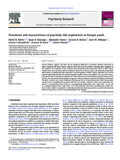| dc.contributor.author | Ndetei David M. | |
| dc.contributor.author | Muriungi, SK | |
| dc.contributor.author | Owoso, A | |
| dc.contributor.author | Mutiso, VN | |
| dc.contributor.author | Mbwayo, AW | |
| dc.contributor.author | Khasakhala, LI | |
| dc.contributor.author | Barch, DM | |
| dc.contributor.author | Mamah, D | |
| dc.date.accessioned | 2013-04-26T15:00:13Z | |
| dc.date.available | 2013-04-26T15:00:13Z | |
| dc.date.issued | 2012 | |
| dc.identifier.citation | Psychiatry Res. 2012 Apr 30;196(2-3):235-42 | en |
| dc.identifier.uri | http://www.ncbi.nlm.nih.gov/pubmed/22460129 | |
| dc.identifier.uri | http://erepository.uonbi.ac.ke:8080/xmlui/handle/123456789/17261 | |
| dc.description.abstract | Current evidence suggests that there may be significant differences in psychotic symptom prevalence in Africa compared with other cultures. However, there have been few studies evaluating these symptoms in the continent. We conducted a cross-sectional survey of psychotic-like experiences (PLEs) in 2963 Kenyan students from seven tertiary academic institutions spread across Kenya, using a self-administered psychosis questionnaire evaluating psychotic experiences and demographic variables. Logistic regression was used to evaluate relationship between PLEs and demographic variables. Latent class analysis (LCA) was used to determine specific classes of psychotic experiences. Twenty-three percent of respondents reported having at least one PLE, and 19% reported this unrelated to drug use or sleep. Compared to students identifying as Protestant Christians, Catholics had a lower likelihood of having any PLE or visual hallucinations. Other demographic variables were not significantly associated with PLEs. LCA of PLEs resulted in a three-class model that comprised 1) a non-psychotic class (83.8%), 2) a predominantly hallucinatory class ("type I PLE"; 12.7%), and 3) a multiple symptom class ("type II PLE"; 3.5%). Both psychotic classes had a predominance of male students. Further studies are required to clarify functionality and clinical progression associated with observed patterns of psychosis, as well as the generalizability of our findings | en |
| dc.language.iso | en | en |
| dc.title | Prevalence and characteristics of psychotic-like experiences in Kenyan youth | en |
| dc.type | Article | en |
| local.publisher | Department of Psychiatry, University of Nairobi, Kenya | en |


